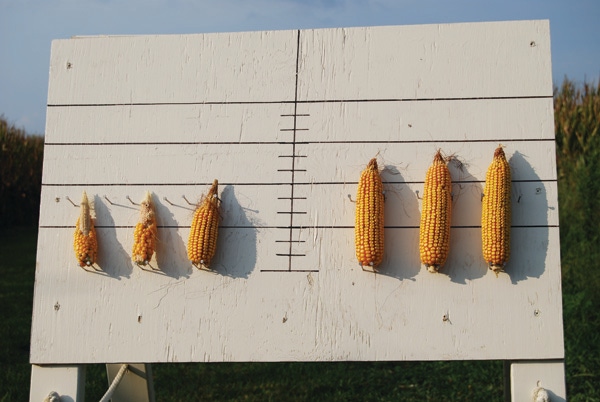January 2, 2013

Corn and soybean growers are using many tools to optimize yields, including fungicides. As a result, the acres of fungicide-treated crops have greatly expanded. In response, fungicide makers have been building their portfolios to help farmers manage disease throughout the growing season. Here is a snapshot of what to expect over the next 24 months.
DuPont Crop Protection
DuPont Crop Protection is expecting EPA registration soon for Aproach, a broad-spectrum fungicide to fight several foliar and soil-borne diseases, including frogeye leaf spot, soybean white mold, brown spot and Asian soybean rust in soybeans. In corn, it may be used to control gray leaf spot, Northern and Southern corn leaf blights, and common rust.
In large-scale field trials across the Midwest last year, corn treated with Aproach yielded on average 8.1 bu./acre more than untreated checks. In soybean trials in the Midwest and mid South, Aproach-treated soybeans yielded an average of 3.4 bu./acre more than untreated checks.
The fungicide translocates to newly emerging leaves and deeper into the canopy. It also provides coverage closer to the soil floor, where diseases like soybean white mold and gray leaf spot in corn start.
To provide added protection against disease resistance, DuPont Crop Protection expects to introduce Aproach Prima with different modes of action for the 2014 growing season.
MANA Crop Protection
For the 2013 growing season, MANA Crop Protection is introducing Bumper ES, an advanced propiconazole formulation for broad spectrum foliar fungal disease in corn and soybeans. It provides preventive and curative control of anthracnose, brown leaf spot, frogeye leaf spot, gray leaf spot, powdery mildew, rust and a number of other diseases affecting crops in the Midwest.
Using proprietary technology, Bumper ES provides solid disease control at the same levels of current emulsifiable concentrate (EC) products, says David Downing, MANA senior product leader. Downing points out that as a Group 3 fungicide, Bumper ES minimizes the development of disease resistance when rotated with other modes of action.
MANA also plans to introduce a combination strobilurin and triazole fungicide in early 2014.
Syngenta
“Growers are using more fungicides on corn and soybeans to get optimal yields,” says Andrew Fisher, Syngenta fungicide product lead. “We’ve seen growers increase the amount of fungicide-treated acreage for three consecutive years.”
This past year, soybean growers showed interest in university trials of Quadris Top, a new fungicide that provides preventive and curative control of strobilurin-resistant frogeye leaf spot. In tests, soybeans treated with the fungicide yielded 4 to 8 bu./acre more than untreated checks and 2 to 3 bu./acre more than straight strobilurin-treated soybeans. It takes just 1 bu./acre more to pay for the fungicide, Fisher says. “That’s a 4:1 to 5:1 return on soybeans.”
In corn, Quilt Xcel, an azoxystrobin fungicide, may be applied as early as the V4 stage. Earlier application helps corn stand later in the season. “Growers can apply Quilt Xcel at the same time as Halex GT herbicide, which also offers the grower convenience,” Fisher says. Growers who applied Quilt Xcel last season were getting bigger ears and more tip fill with a 6- to 8-bu./acre yield bump, he adds. “Even 2.5 kernels per ear can mean an additional bushel per acre.”
Fisher adds that in 2012, Quilt Xcel appeared to help improve plant transpiration, allowing corn plants to retain moisture during drought stress.
Cheminova
Topguard received EPA registration for use in corn in 2012 and in soybeans in 2010. In these crops, Topguard is used alone, or in combination with other products, as a foliar spray to control several key diseases. In soybeans, for example, the fungicide controls strobilurin-resistant frogeye leaf spot and Cercospora leaf blight, says Deneen Sebastian, fungicide portfolio manager.
Topguard’s triazole formulation offers long-lasting control, enabling growers to plan a disease control spray program that protects their crop earlier and longer into the season.
“The best way to solve a problem is to prevent it,” Sebastian says. “By the time a grower observes disease in the field, plant health is already compromised and yields may be in jeopardy. A program that relies on catching up with curative products is unlikely to restore lost yield or bring back plant health. Planned, early season disease management lays the foundation for healthy plants with minimal disease.”
BASF
Priaxor is BASF’s newest fungicide combining F500 (pyraclostrobin), the active ingredient in Headline fungicide, and Xemium (fluxapyroxad). There was a limited launch in 2012 for Priaxor for soybeans. A more aggressive launch is planned for 2013.
Data from more than 40 field trials in 2012 indicated that soybeans treated with Priaxor yielded 2 bu./acre more than soybeans treated with Headline, says Brianne Reeves, BASF plant health.
In corn, Priaxor may be applied between the V5 stage to tasseling to control several diseases, including anthracnose, gray leaf spot, Northern and Southern corn leaf blights, rusts and more.
BASF continues to expand its fungicide program to serve several markets, including corn and soybeans as well as alfalfa, cotton and specialty crops.
About the Author(s)
You May Also Like




